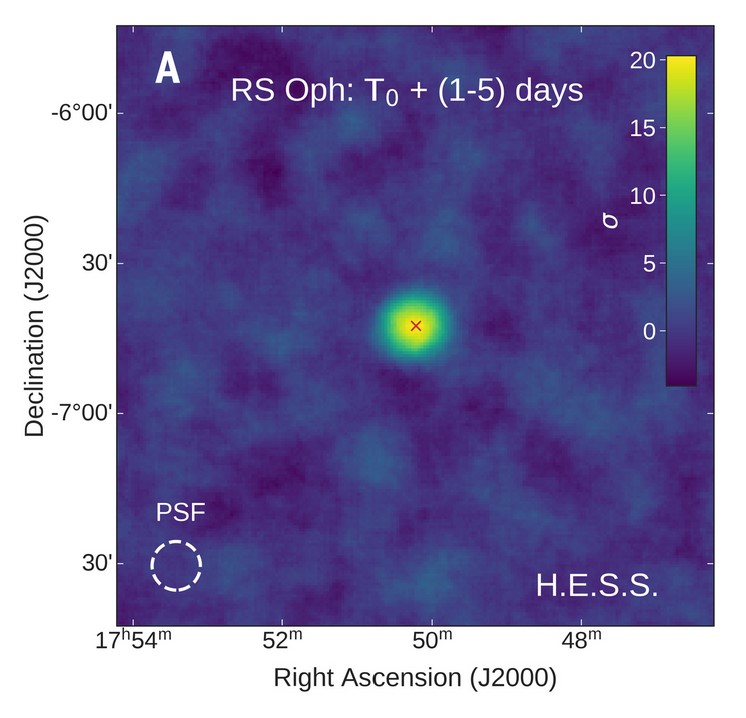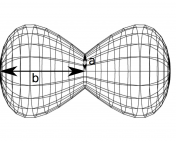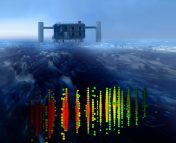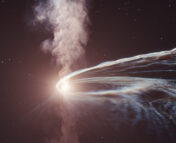Title: Neutrino Flux Deduced from gamma-rays Emitted by Novae
Authors: Dafne Guetta, Yael Hillman, and Massimo Della Valle
First Author’s Affiliations: Department of Physics, Ariel University, Ariel, Israel
Status: Submitted to the Astrophysical Journal, open access on ArXiv
In the search for the highest energy sources in the universe, we often hear about supernovae, the deaths of stars, but what about novae? Novae, the “little cousin” of supernovae, are non-cataclysmic, meaning the outburst leaves the system intact. They happen when a white dwarf and another star are in a binary system, and matter from the larger star accretes onto the white dwarf, until a runaway thermonuclear reaction occurs, which causes the ejection of material from the surface and a bright burst of photons. Novae come in three main types – classical, recurrent, and dwarf novae.
Novae have historically been seen primarily in the optical regime, but also can be observed in other bands over the course of its cycle, including UV, IR, and X-rays. But recently, some novae have also been seen in gamma rays, the highest energy photons in the universe (see figures 1 & 2). In order to observe gamma rays, particles must be being accelerated in or around the nova, but the key to understanding these processes is to figure out where particles could be accelerated to these extremely high energies.


Novae – the next high-energy particle accelerators?
Gamma rays that are observed from novae are a hint that the environment around novae is able to accelerate particles to extremely high energies – but how does it do this, and what does it tell us?
As mass is ejected from the surface of the white dwarf in the nova, it is thought that it can produce an astrophysical shock wave – like when a plane travels faster than the speed of sound and produces a shock which is heard as a sonic boom. This shock is capable of accelerating particles to extremely high energies, which then smash into each other and produce these very high energy gamma rays. But if this is the production mechanism for these gamma rays, we should also see high energy neutrinos produced at the same time. So these authors seek to answer the question – why haven’t neutrino detectors seen neutrinos from novae yet?
Why haven’t neutrino detectors seen novae?
Thus far, no neutrino detector has reported seeing neutrinos coming from novae. These authors discuss several current and future neutrino detectors, including:
- The IceCube Neutrino Observatory: a current neutrino telescope operating in the ice at the South Pole. The main array is sensitive to high energy neutrinos with energies above 100 GeV, but also has a denser infill array, called DeepCore, in the center of the detector that can observe lower energy neutrinos from a few GeV to some tens of TeV.
- ANTARES: a water-based neutrino telescope located in the Mediterranean Sea which has recently been deconstructed (to make way for the next generation neutrino telescope, KM3NET). It is primarily sensitive to neutrinos above 100 GeV.
- KM3NET: a water-based neutrino telescope that is currently under construction. It is planned to have two arrays, called ORCA and ARCA. ARCA will be most sensitive to neutrinos at TeV energies, while ORCA will target lower energy neutrinos of a few GeV.
- Hyper-K: a next generation water neutrino detector in Japan, which is the successor to another detector, Super-K. It will have good lower energy resolution to neutrinos with GeV energies.
So, why haven’t we seen any neutrinos from novae with these detectors? Does that mean our model for the high-energy gamma rays emission we see is wrong? These authors investigate how many neutrinos each of these detectors could see from a nova like RS Ophiuchi, which is a recurrent nova that erupts about every 15 years and is about 2.3 kiloparsecs away from us. They find only a small fraction of a neutrino is observable at any of these detectors on average, meaning that a detection is highly improbable (see table 1).
| Detector | High Energy (TeV or more) | Low energy (GeV neutrinos) |
|---|---|---|
| IceCube/DeepCore | 0.0014 (IceCube) | 0.061 (DeepCore) |
| ANTARES | 0.00036 | – |
| KM3NET | 0.021 (ARCA) | 0.046 (ORCA) |
| Hyper-K | – | 0.014 |
The authors repeat this for 6 other novae, and set an estimated limit on the distance a nova can be from us in order to see neutrinos from novae. With IceCube and DeepCore, this limit is about 1 kiloparsec (kpc), while for KM3NET this limit could be out to 2 kpc.
What does this mean for future detectors and the theory?
Even though this result is somewhat disappointing, because it shows it is unlikely we can see any neutrinos from novae with current neutrino detectors, it also doesn’t contradict the theory for where these high energy gamma rays are coming from.
If we were to see a nova within the 1 kpc distance limit that the authors set (or 2 kpc, once KM3NET is finished with construction), then there would be a better chance to see neutrinos from novae, which could tell us how particles are being accelerated in the environment near a nova!
Edited by: William Balmer
Featured Image Credit: NASA/CXC/M.Weiss, Public domain, via Wikimedia Commons




